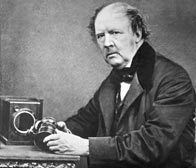William Henry Fox Talbot Invents Modern Photography
William Henry Fox Talbot (Feb. 11, 1800 - Sept. 17, 1877) was an upperclass English intellectual with interests in math, chemistry, botany, astronomy, philosophy, and art history. He lived at his estate, Lacock Abbey, about 85 miles west of London, near Bath. In addition to his achievements in photographic invention, he wrote 4 books and many scholarly articles, and served for a time as a Member of Parliament.
Talbot began experimenting with photography in 1834. He was still developing his method when Daguerre's system, the daguerreotype, was announced in 1839. But Talbot kept at it. By 1841, he had invented the Calotype, in which the light created a latent image on the paper that had to be brought out by development. Fixing the image (that is, making it permanent) was still a problem. Sir John Herschel, a friend of Talbot's, suggested what turned out to be the solution. He proposed using hyposulfite of soda to fix the image. It wasn't a perfect answer, but, with further refinements, this process is the basis for film photography as it has been practiced ever since. The calotype required shorter exposure times of about a minute, compared to daguerreotypes, which took closer to an hour.
His book, The Pencil of Nature, was the first book to have photographic illustrations.
Talbot began experimenting with photography in 1834. He was still developing his method when Daguerre's system, the daguerreotype, was announced in 1839. But Talbot kept at it. By 1841, he had invented the Calotype, in which the light created a latent image on the paper that had to be brought out by development. Fixing the image (that is, making it permanent) was still a problem. Sir John Herschel, a friend of Talbot's, suggested what turned out to be the solution. He proposed using hyposulfite of soda to fix the image. It wasn't a perfect answer, but, with further refinements, this process is the basis for film photography as it has been practiced ever since. The calotype required shorter exposure times of about a minute, compared to daguerreotypes, which took closer to an hour.
His book, The Pencil of Nature, was the first book to have photographic illustrations.



Photography undergoes extraordinary changes in the early part of the twentieth century. This can be said of every other type of visual representation.
ReplyDelete